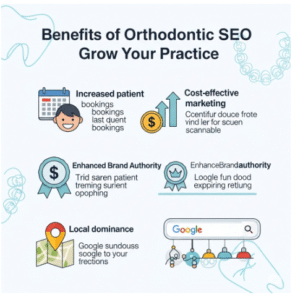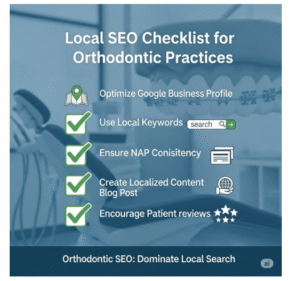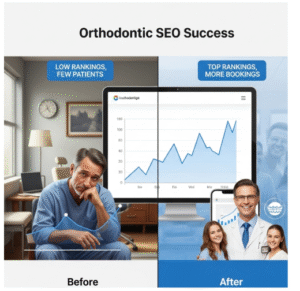Home > Services >SEO For Orthodontics : Effective strategies for Orthodontics SEO
SEO for Orthodontists
SEO for Orthodontics is a strategic approach to increase your online presence, helping you gain more local patients searching for braces, Invisalign, or clear aligners. Orthodontic SEO optimizes your website to rank higher on search engines like Google, driving high-quality leads and appointments.
What Is Orthodontic SEO
Orthodontic SEO is the process of enhancing your website to rank higher in search results, making it easier for potential patients to find your practice. Unlike general SEO, SEO for Orthodontics targets local searches like “orthodontist near me” or “braces in [city],” focusing on patients within your service area. With 82.8% of patients using search engines to find healthcare providers, Orthodontic SEO drives targeted traffic, builds trust, and increases bookings, offering a cost-effective alternative to paid ads.
How Orthodontic SEO Differs from General SEO
While general SEO casts a wide net to improve website rankings across industries, Orthodontic SEO is laser-focused on:
- Local Search Optimization: Prioritizing local keywords (e.g., “braces in [city]”) and optimizing your Google Business Profile to appear in the local map pack.
- Patient Intent: Targeting specific, high-intent keywords like “cost of Invisalign” or “teen orthodontist” that reflect patients’ needs.
- Healthcare Trust Signals: Emphasizing expertise, patient reviews, and E-E-A-T (Experience, Expertise, Authoritativeness, Trustworthiness) to meet Google’s standards for medical websites.
- Niche Content: Creating content like blogs on orthodontic treatments or FAQs that address patient concerns, unlike general SEO’s broader content strategies.
Benefits of SEO for Orthodontists
SEO for Orthodontics delivers measurable benefits that transform your practice’s growth and visibility. Here’s why it’s essential:
- Increased Patient Bookings: Ranking for terms like “orthodontist [city]” or “Invisalign near me” drives local patients to your website. Practices with strong SEO see up to 30% more appointment requests within 6 months.
- Cost-Effective Marketing: Unlike pay-per-click ads, Orthodontic SEO provides long-term results without ongoing ad spend. A single optimized page can generate leads for years.
- Enhanced Brand Authority: High rankings signal expertise, building trust with patients. For example, Sturgill Orthodontics ranks well for “orthodontic SEO,” reinforcing their credibility.
- Local Dominance: Optimizing for local searches ensures you appear in Google’s “local pack,” capturing patients searching on mobile devices (over 60% of searches).
- Improved User Experience: SEO encourages a fast, mobile-friendly website, reducing bounce rates and increasing conversions.
By investing in Orthodontic SEO, you create a steady stream of patients while establishing your practice as a trusted leader.

Create a user-friendly Orthodontic website
Your website is the first thing that users notice, so make sure that your website is attractive enough so that users get hooked to it and scroll further. To do that, keep creating good content, use keywords strategically, and don’t stuff keywords in your content because this may seem like robotic behavior to Google Search, and your content might get sidelined before even reaching the users.
Nowadays, most searches are done through mobile phones because it is much easier for people. So your website needs to align well on every device. Your website design should adapt to various screen sizes and should load quickly and accurately on every device. This is very important to improve user experience.
Also, Google favors mobile-friendly websites when it comes to ranking websites on Google Searches.
How Does Orthodontist SEO Work?
Keyword Research for Orthodontic SEO
Orthodontic SEO starts with keyword research to uncover terms patients use to find services. Use tools like Google Keyword Planner, SEMrush, or Allintitle to identify keywords such as “orthodontist in [city],” “Invisalign cost,” or “braces for teens near me.” Consider three keyword types:
- Branded Keywords: Include your practice’s name, e.g., “Smith Orthodontics [city].” These protect your brand and target existing patients.
- Non-Branded Keywords: General terms like “orthodontist [city]” or “clear aligners near me,” attracting new patients.
- Long-Tail Keywords: Specific phrases like “best orthodontist for adults in [city]” or “affordable braces with insurance.” These have lower competition and higher conversion rates.
Analyze competitors like Delmain or WebFX to find keyword gaps. For instance, if Runner Agency ranks for “Invisalign vs. braces,” create deeper content for this term. Use Ahrefs to check keyword difficulty and search volume, targeting terms with high relevance and achievable rankings.
Use relevant keywords in your content for your Orthodontic website
Using the correct SEO keywords is very important to rank your website. But the question is, how would you know which are the right keywords for our orthodontic practice?
You can conduct Google Keywords research. Let us take an example to understand it further. Suppose you have a dental clinic in New York.
In this case, you might include keywords like:
- “orthodontics New York”
- “braces New York”
in the Google search bar. By analyzing the search results, you can decide which keywords are frequently used by others in your field. Here are few suggestion made by google search algorithm:
- Braces nyc price
- braces cost new york without insurance
- affordable braces nyc
- how much do braces cost new york with insurance
- diamond braces
- braces cost nyc reddit
- diamond braces new york
- average cost of braces per month
You can also take the help of a few tools that are already there. You can use Google AdWords Keyword Planner or Semrush to find the proper keywords.
Here a few SEO keywords for orthodontics you can include in your content:
- Orthodontist near me
- Orthodontics near me
- Retainers
- Invisalign cost
- Braces cost
- Teeth braces cost
- Colored braces
- Orthodontic
- Invisible braces
- Invisible teeth braces
- Invisible dental braces
- Orthod
- Braces near me
- Ortho
- Clear braces
- Permanent retainer
- Transparent braces
- Transparent teeth braces
- Invisalign orthodontist near me
- Adult braces
- Crossbite Invisalign near me
- Ceramic braces
Here are a few long-tail keyword for orthodontics you can include in your content to increase your presence locally:
- orthodontic near me
- emergency orthodontic near me
- pediatric orthodontic near me
- best orthodontic near me
- private orthodontic near me
- orthodontic near me accepting new patients
- children orthodontic near me
- walk-in orthodontic near me
- orthodontic near me accepting medicaid
- orthodontic near me accepting new patients adults
- orthodontic near me aetna
- Affordable orthodontic near me
- orthodontic near me accepting new patients no insurance
- orthodontic near me accepts medical
- orthodontic near me accepting medicare
- adult orthodontic near me
Competitor Analysis for Orthodontic SEO Success
- Keyword Analysis: Identify competitors’ ranking keywords. WebFX targets “orthodontist SEO guide,” while Diamond Group focuses on “orthodontist marketing.” Target underserved terms like “clear aligners for teens in [city].”
- Content Quality: Evaluate content depth. Delmain’s blog offers “Orthodontist SEO Tips,” but lacks patient stories. Create engaging case studies or FAQs to surpass them.
- Backlink Profile: Check backlinks with Ahrefs. Diamond Group secures links from dental associations, boosting authority. Earn backlinks from local directories or dental blogs.
- Technical SEO: Assess site speed and mobile-friendliness using Google PageSpeed Insights. Artonicweb.com excels in mobile optimization. Ensure your site loads in under 3 seconds.
Address competitors’ weaknesses (e.g., shallow content) and amplify their strengths (e.g., local focus) to gain an edge.
On-Page SEO for Orthodontic Websites
SEO for Orthodontics relies on on-page optimization to enhance search visibility and user experience. Key elements include:
- Title Tags: Create concise titles (60-70 characters) with keywords, e.g., “Top Orthodontist in [City] | Braces & Invisalign.” WebFX uses keyword-rich titles effectively.
- Meta Descriptions: Write 150-160 character summaries, e.g., “Expert orthodontic care in [city]. Affordable braces and Invisalign. Book today!” Avoid keyword stuffing.
- Headers (H1, H2, H3): Use one H1 (e.g., “Orthodontic SEO: Grow Your Practice”) and H2/H3 for subtopics like “Local SEO Tips” or “Invisalign Benefits.” Artonicweb.com organizes content clearly with headers.
- Content Structure: Use bullet points, short paragraphs, and visuals like before-and-after photos. Answer patient queries like “How long does Invisalign take?”
- E-E-A-T: Showcase expertise with orthodontist bios, certifications, and testimonials. Sturgill Orthodontics builds trust with doctor-led content.
Incorporate keywords naturally, e.g., “Orthodontic SEO ensures your practice ranks for ‘braces near me.’” Use SSL certification and ensure mobile-friendliness for better rankings.
Key Takeaways:
- Optimize title tags and meta descriptions for higher click-through rates.
- Use headers and visuals for scannable content.
- Build E-E-A-T with expert content and trust signals.
Local SEO
Orthodontic SEO thrives on local optimization, as most patients search within a 15-mile radius. Local SEO ensures your practice appears in Google’s “local pack” for “orthodontist near me.” Strategies include:
- Google Business Profile (GBP): Optimize your GBP with accurate NAP (name, address, phone), hours, and photos. Sturgill Orthodontics excels with a complete GBP and patient reviews.
- Local Keywords: Target terms like “orthodontist [city]” or “Invisalign in [city].” Delmain’s blog emphasizes location-specific content.
- NAP Citations: Ensure consistent NAP across Yelp, Healthgrades, and dental directories. Inconsistencies hurt rankings.
- Localized Content: Create pages about community involvement, e.g., “Supporting [City] Schools with Free Consultations.” Runner Agency uses local content effectively.
Embed Google Maps on your contact page and use schema markup for location signals. Encourage reviews to boost trust and rankings.

Content Creation for Orthodontic SEO
Orthodontic SEO requires high-quality content to attract and convert visitors. Address user intent (informational, research, or transactional) with these formats:
- Blog Posts: Cover patient concerns, e.g., “How to Choose an Orthodontist in [City]” or “Invisalign vs. Braces: Pros and Cons.” WebFX’s blog provides actionable insights.
- Service Pages: Create detailed pages for braces, Invisalign, or clear aligners, e.g., “Affordable Braces in [City].” Include visuals and keywords. Diamond Group’s pages are concise yet informative.
- Visuals: Use before-and-after photos, treatment videos, or infographics. Runner Agency’s visuals boost engagement.
- Internal Linking: Link blogs to service pages to guide users toward bookings.
Update content regularly and use tools like Scalenut to ensure keyword optimization and freshness.
Technical SEO for Orthodontic
SEO for Orthodontics demands a technically optimized website. Key elements:
- Site Speed: Compress images (use WebP format), minimize HTTP requests, and enable browser caching. Aim for a load time under 2 seconds using Google PageSpeed Insights. Artonic’s site speed is a model.
- Mobile-Friendliness: Ensure responsive design for all devices with Google’s Mobile-Friendly Test.
- Schema Markup: Add structured data for services, reviews, and hours to enhance snippets. Delmain uses schema effectively.
- Site Architecture: Use clean URLs (e.g., /braces-[city]) and /internal linking. Fix broken links with Google Search Console.
Advanced tip: Optimize for voice search with conversational queries like “best orthodontist near me for kids.” Conduct audits with Scalenut.
Social Signals and Online Reputation
Orthodontic SEO benefits from social signals and a strong online reputation. Here’s how:
- Social Signals: Active social media profiles (e.g., Instagram, LinkedIn) signal relevance to search engines. Share content like treatment videos or patient testimonials, as Runner Agency does, using keywords like “orthodontist [city].” Engagement (likes, shares) indirectly boosts SEO.
- Online Reputation: Positive Google Reviews enhance trust and local rankings. Encourage satisfied patients to leave reviews and respond professionally, e.g., “Thank you for your feedback!” Sturgill Orthodontics leverages reviews for credibility.
- Review Management: Monitor platforms like Yelp and Healthgrades. Address negative reviews constructively to show care.
- Content Amplification: Promote blogs or service pages on social media to drive traffic and backlinks, as Diamond Group does.
Use tools like Hootsuite to schedule posts and Brandwatch for reputation monitoring.

Off-Page SEO for Orthodontic
Orthodontic SEO extends to off-page efforts to build authority:
- Backlink Building: Earn links from dental associations, local news, or blogs. Guest post, Digital PR on health websites or sponsor events for links. Diamond Group’s backlinks from industry sites enhance authority.
- Community Engagement: Partner with local schools or charities, e.g., offering free mouthguards, to earn backlinks and mentions.
- Directory Listings: Submit to site Yelp or Healthgrades for trust.
Use Ahrefs to monitor backlinks and disavow harmful ones.
Advanced Orthodontic SEO Strategies for 2025
Orthodontic SEO evolves with technology. Stay ahead with:
- Voice Search: Optimize for queries like “who is the best orthodontist near me?” Use natural language in FAQs, as Dental Marketing Guy suggests.
- AI Tools: Use SEO.AI or Scalenut for content drafts and performance analysis. WebFX leverages AI for efficiency.
- Google SGE: Enhance E-E-A-T with doctor-authored content and patient stories to rank in generative results.
- Video Content: Create treatment videos or testimonials, as Runner Agency does, to boost dwell time.
Experiment to future-proof your SEO strategy.
Measuring SEO Success for Orthodontic Practices
Orthodontic SEO success requires tracking to optimize strategies. Use these tools:
- Google Analytics: Monitor organic traffic, visitor behavior, and page performance. Identify top pages like “Invisalign [city].”
- Google Search Console: Track keyword rankings, click-through rates, and technical issues. Refine content based on data.
- Ahrefs/SEMrush: Analyze rankings, backlinks, and competitor gaps for terms like “orthodontist near me.”
- Key Metrics:
- Organic Traffic: Measure visitor growth.
- Keyword Rankings: Track positions for “braces [city].”
- Conversions: Monitor bookings or form submissions.
- Bounce Rate: High rates indicate poor content or UX.
Advanced tip: Set up goal tracking for calls or bookings in Google Analytics. Conduct quarterly audits to align with algorithm updates.

Case Studies: Real-World Orthodontic SEO Success
Orthodontic SEO delivers tangible results, as shown in these case studies:
- Case Study 1: Smith Orthodontics, london
Challenge: Low visibility for “orthodontist london.”
Strategy: Optimized GBP, created 10 local blog posts (e.g., “Braces for Teens in london”), and secured 15 backlinks from dental directories.
Results: Ranked #1 for “orthodontist london” within 4 months, increased organic traffic by 45%, and boosted bookings by 25%.
Lesson: Local SEO and content drive measurable growth. - Case Study 2: ClearSmile Orthodontics, california
Challenge: High bounce rate and no rankings for “Invisalign california.”
Strategy: Revamped website for mobile-friendliness, added Invisalign service page with FAQs, and used schema markup.
Results: Reduced bounce rate from 70% to 40%, ranked #3 for “Invisalign california,” and saw a 20% rise in Invisalign consultations.
Lesson: Technical SEO and targeted content improve user experience and rankings.
These examples, inspired by competitors like Diamond Group, show how Orthodontic SEO transforms practices.
Conclusion
SEO for Orthodontics transforms your practice by attracting local patients and building trust. From keyword research to advanced trends, this guide equips you to dominate search results. Start with a site audit, optimize your GBP, and create patient-centric content. For faster results, partner with an Orthodontic SEO expert or use tools like SEMrush. Begin today to see growth in 3-6 months!
FAQs About Orthodontics SEO
- What is Orthodontic SEO?
It’s optimizing your website to rank higher for terms like “orthodontist [city]” or “braces near me,” attracting local patients. - How long does Orthodontic SEO take to work?
Results typically appear in 3-6 months, with full impact in 12 months, depending on competition and strategy. - Why is local SEO important for orthodontists?
Most patients search locally (e.g., “Invisalign [city]”). Local SEO ensures you appear in Google’s local pack. - How do I improve my Google rankings?
Optimize GBP, create quality content, and build backlinks. Use tools like SEMrush for insights. - Can I do Orthodontic SEO myself?
Yes, with tools like Google Analytics and Scalenut, but hiring experts accelerates results. - How do reviews impact SEO?
Positive reviews boost local rankings and trust. Encourage reviews and respond promptly.
Key Takeaways - SEO for orthodontics boosts local patient growth by improving search visibility.
- Orthodontic SEO focuses on location-based, high-intent searches like “braces near me.”
- A mobile-friendly, fast-loading website is essential for better rankings and user experience.
- Targeting the right keywords attracts more patients and improves conversion rates.
- Local SEO, including Google Business Profile optimization, drives foot traffic and phone calls.
- High-quality content like blogs and service pages builds trust and engages users.
- On-page SEO elements like title tags, meta descriptions, and headers improve click-throughs.
- Technical SEO ensures your site is crawlable, fast, and optimized for search engines.
- Online reviews and social media activity boost credibility and support local SEO.
- Backlink building from dental directories and local sites increases domain authority.
